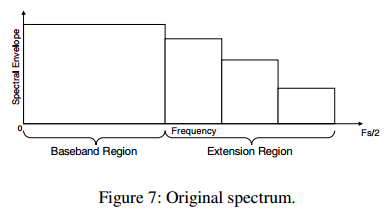1. Introduction to Spectral extension
Spectral extension is the process of synthesizing high-frequency transform coefficients through low-frequency transform coefficients.
The implementation of spectral extension is similar to channel coupling, but since it only needs to transmit some metadata for synthesizing high-frequency transform coefficients, it can reduce datarate more than coupling.
And spectral extension can be used for mono signal, and coupling requires at least 2 channels.
The core part of the spectral extension is the band structure, and the spectral extension band is close to the critical band. The spectral extension calculates the energy ratio and band border based on the band.
The spectrum of the original signal is as follows:

The spectrum of the signal is divided into two parts: the baseband region and the extension region. The extension region is divided into multiple bands based on the band structure, and an energy ratio is calculated for each band. For the entire extension region, it is obtained by measuring the noise-like character of the extension region. A noise blending parameter. After calculating these parameters, the transform coefficient of the extension region of the original signal is discarded.
Next, translate, the process is as follows:

translation copies the transform coefficient of the baseband region to the extension region.
The copied part of the baseband region is called the copy region. Usually the copy region is smaller than the extension region, so the copy region will be copied multiple times to fill the extension region. This process is called wrapping. In Figure 8, the copy region is wrapped twice. The wrap causes a discontinuity in the spectrum at the boundary during translation. Since each band corresponds to a scale factor, if the wrapping occurs within a band, the scale factor does not reduce the discontinuity. If wrapping occurs only on the band border, the scale factor of the two adjacent bands can reduce the discontinuity. So translation ensures that wrapping happens between bands.
Simply copying from the baseband region to the extension region cannot produce a natural sound signal. Because most signals become more like noise as the frequency increases. Therefore, the translated transform coefficients need to be blended with the noise spectrum according to the noise-blending function.
Since most of the signals are more like noise in the high frequency part, the noise-blending function is more weighted in the high frequency part. The noise-blending function is linear, its slope depends on the bandwidth of the original signal, and its intercept depends on the noise blending parameter.
The band energy of the generated noise spectrum is the same as the translated band. The signal obtained by multiplying the noise spectrum by the noise-blending function is as follows:
